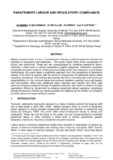| dc.contributor.author | Chitere, Preston | |
| dc.contributor.author | Orero, Risper | |
| dc.contributor.author | Mitullah, Winnie | |
| dc.contributor.author | McCormick, Dorothy | |
| dc.contributor.author | Ommeh, Marilyn | |
| dc.date.accessioned | 2015-03-09T07:43:08Z | |
| dc.date.available | 2015-03-09T07:43:08Z | |
| dc.date.issued | 2013 | |
| dc.identifier.citation | Ommeh, Marilyn, Dorothy McCormick, Winnie Mitullah, Risper Orero, and Preston Chitere. "Paratransit labour and regulatory compliance." SATC 2013 (2013). | en_US |
| dc.identifier.uri | http://hdl.handle.net/11295/81050 | |
| dc.description.abstract | Matatu transport which is a form of paratransit in Kenya provides employment directly and indirectly to institutions and individuals. The sector mainly offers direct employment to drivers and conductors. These two are conceptualised to constitute paratransit labour. Indirectly, it offers work to vehicle assemblers; graphic designers; mechanics; insurance companies and petrol stations. Unlike previous studies which were based on a quantitative methodology, this paper takes a qualitative approach from the perspective of paratransit owners in an effort to explore how the terms of employment of paratransit labour affect regulatory compliance. The findings demonstrate the terms of employment such as the job responsibilities i.e. the minimum target and customer relations; working hours and breaks; and remuneration affect how paratransit labour behaves and interacts with other road users by increasing ridership through competitive behaviour that leads to violation of traffic regulations. Efforts by Government to enhance paratransit labour regulatory compliance should not focus on introducing tougher penalties but addressing the problem of corruption by traffic police and target setting by owners. | en_US |
| dc.language.iso | en | en_US |
| dc.title | Paratransit labour and regulatory compliance. | en_US |
| dc.type | Other | en_US |
| dc.type.material | en_US | en_US |

